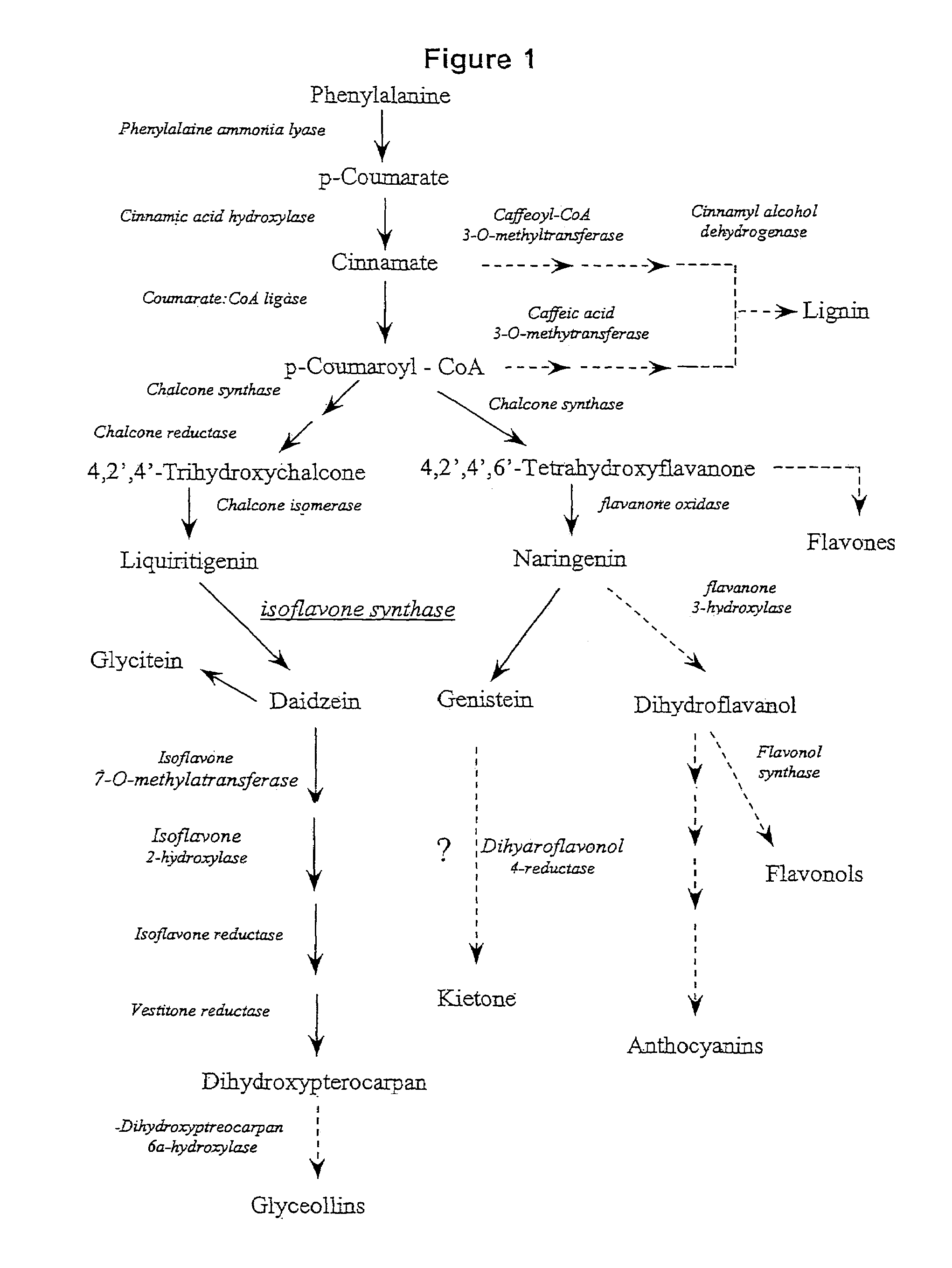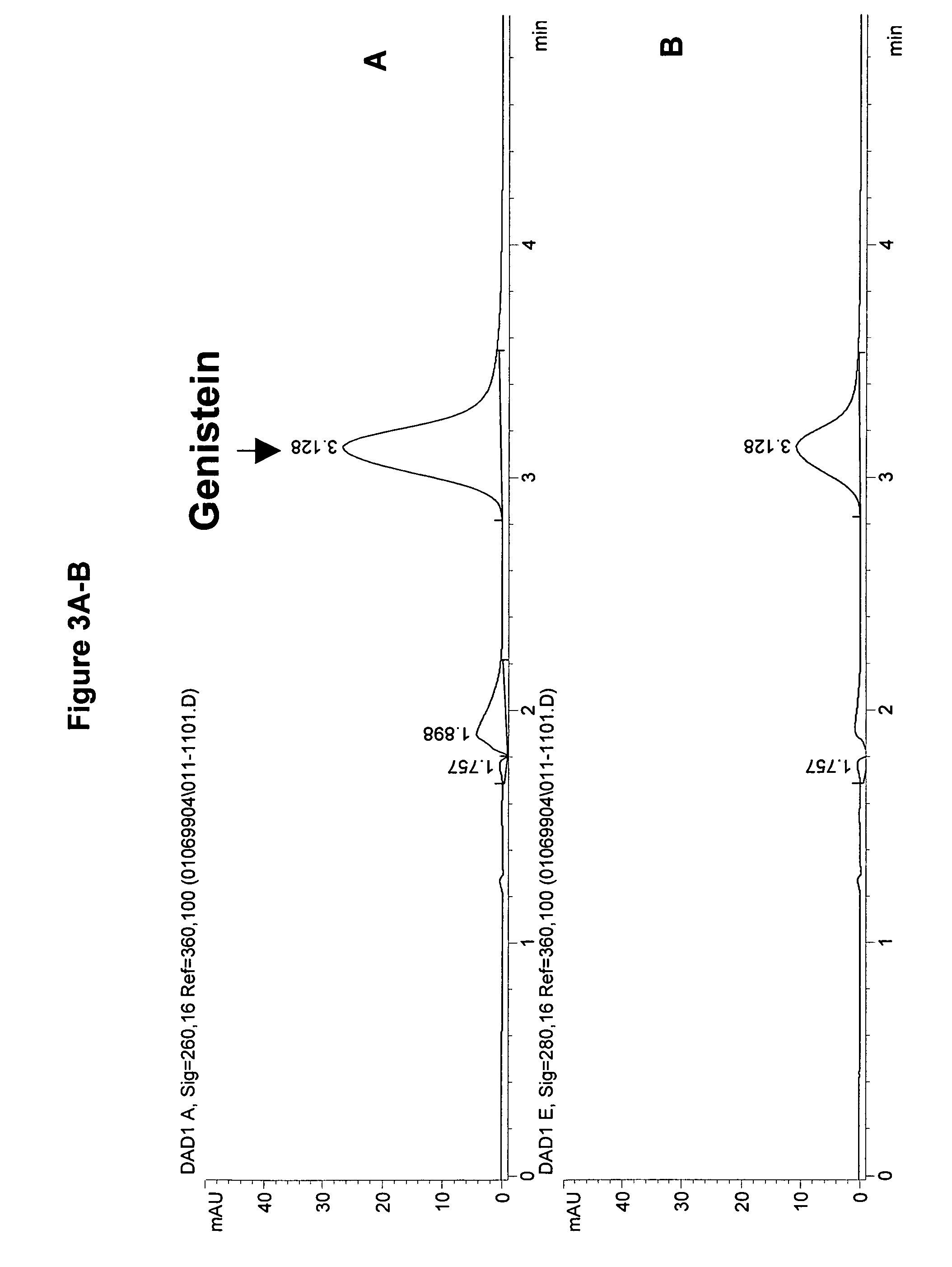Nucleic acid sequences encoding isoflavone synthase
a technology of isoflavone and nucleic acid, applied in the field of plant molecular biology, can solve the problems of unstable 2-hydroxyisoflavanone intermediate, difficult cloning of plant p450s by traditional protein purification strategies, and difficult to develop soybean or other plant lines with consistently high levels of isoflavon
- Summary
- Abstract
- Description
- Claims
- Application Information
AI Technical Summary
Benefits of technology
Problems solved by technology
Method used
Image
Examples
example 1
Microsome Preparation from Elicitor-Treated Soybean Hypocotyls and Elicitor-Treated Cell Suspension Culture
Elicitor Treatment of Soybean Seeds
[0169]Soybean seeds were placed on a bed of vermiculite (5 to 6 cm thick) and covered with a layer of vermiculite about 2 cm thick. Seeds were germinated for five days in a growth chamber until the average length of hypocotyls reached to about 3 to 4 cm. The growth chamber was kept at a cycle that consisted of a 14 h light period at 25° C. and a 10 h dark period at 21° C. Illumination was supplied from cool white fluorescent and incandescent lamps that provide a photon flux density of 450 μEm−2s−1. Soybean hypocotyls were pulled out from the vermiculite bed and were placed on wet paper towels. The soybean hypocotyls were divided into two groups: one of the groups was treated with elicitor and the other was not treated.
[0170]Elicitor treatment was conducted as follows. The epidermal surfaces of the hypocotyls were opened using a razor blade. Th...
example 2
Development of Isoflavone Synthase Assay
[0173]An assay to measure isoflavone synthase activity was developed using either of the two substrates of isoflavone synthase, (±) naringenin (4′,5,7-trihydroxyflavanone; Sigma, N-5893) or liquiritigenin monohydrate (4′,7-dihydroxyflavanone; Indofine, 02–1150S), dissolved in 80% ethanol. The reaction mixture was prepared at room temperature and consisted of 100 μM naringenin or liquiritigenin, 80 mM K2HPO4, 0.5 mM glutathione (Sigma, G-4251), 20% w / v sucrose, and 30 to 150 μg of microsome preparation. The reaction mixtures were preincubated for 5 minutes without NADPH (synthesis of genistein and daidzein requires NADPH as a co-factor). The volume of microsomes and substrate added to any one reaction did not exceed 5% and 1%, respectively, of the total reaction volume. A typical reaction volume was 250 μL. The reaction was started by the addition of 40 nmol of NADPH per each 100 μL of final reaction volume. The pH of the reaction mixture was 8...
example 3
Composition of Soybean cDNA Library, Isolation and Sequencing of cDNA Clone
[0180]A cDNA library was prepared using mRNAs from soybean seeds that had been allowed to germinate for 4 hours. The library was prepared in Uni-ZAP™ XR vector according to the manufacturer's protocol (Stratagene Cloning Systems, La Jolla, Calif.). Conversion of the Uni-ZAP™ XR library into a plasmid library was accomplished according to the protocol provided by Stratagene. Upon conversion, cDNA inserts were contained in the plasmid vector pBluescript. cDNA inserts from randomly picked bacterial colonies containing recombinant pBluescript plasmids were amplified via polymerase chain reaction using primers specific for vector sequences flanking the inserted cDNA sequences or plasmid DNA was prepared from cultured bacterial cells. Amplified insert DNAs or plasmid DNAs were sequenced in dye-primer sequencing reactions to generate partial cDNA sequences (expressed sequence tags or “ESTs”; see Adams, M. D. et al. ...
PUM
| Property | Measurement | Unit |
|---|---|---|
| retention time | aaaaa | aaaaa |
| temperature | aaaaa | aaaaa |
| temperature | aaaaa | aaaaa |
Abstract
Description
Claims
Application Information
 Login to View More
Login to View More - R&D
- Intellectual Property
- Life Sciences
- Materials
- Tech Scout
- Unparalleled Data Quality
- Higher Quality Content
- 60% Fewer Hallucinations
Browse by: Latest US Patents, China's latest patents, Technical Efficacy Thesaurus, Application Domain, Technology Topic, Popular Technical Reports.
© 2025 PatSnap. All rights reserved.Legal|Privacy policy|Modern Slavery Act Transparency Statement|Sitemap|About US| Contact US: help@patsnap.com



